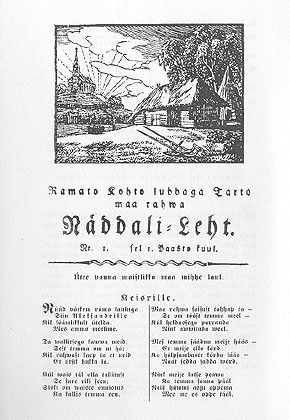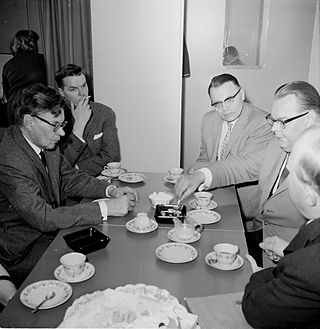
The Kalevala is a 19th-century work of epic poetry compiled by Elias Lönnrot from Karelian and Finnish oral folklore and mythology, telling an epic story about the Creation of the Earth, describing the controversies and retaliatory voyages between the peoples of the land of Kalevala called Väinölä and the land of Pohjola and their various protagonists and antagonists, as well as the construction and robbery of the epic mythical wealth-making machine Sampo.
Finnish mythology is a commonly applied description of the folklore of Finnish paganism, of which a modern revival is practiced by a small percentage of the Finnish people. It has many features shared with Estonian and other Finnic mythologies, but also shares some similarities with neighbouring Baltic, Slavic and, to a lesser extent, Norse mythologies.

Kalevipoeg is a 19th century epic poem by Friedrich Reinhold Kreutzwald which has since been considered the Estonian national epic.
Nordic folk music includes a number of traditions of Nordic countries, especially Scandinavian. The Nordic countries are Iceland, Norway, Sweden, Denmark and Finland.

Väinämöinen is a demigod, hero and the central character in Finnish folklore and the main character in the national epic Kalevala by Elias Lönnrot. Väinämöinen was described as an old and wise man, and he possessed a potent, magical singing voice.
The recorded history of music in Estonia dates back as far as the 12th century.

Setos are an indigenous Finnic peoples and linguistic minority that have historically lived in the borderlands between modern day Estonia and Russia. Setos have historically spoken the Seto language and been Orthodox Christians. The Seto language belongs to the Finnic group of the Uralic language family. Since the early 2000s, the Setos have sought greater recognition, rather than having their language considered a dialect of Estonian. Eastern Orthodox Christianity, with influences from local folk religions is widely practiced by the Seto peoples.
Estonian mythology is a complex of myths belonging to the Estonian folk heritage and literary mythology. Information about the pre-Christian and medieval Estonian mythology is scattered in historical chronicles, travellers' accounts and in ecclesiastical registers. Systematic recordings of Estonian folklore started in the 19th century. Pre-Christian Estonian deities may have included a god known as Jumal or Taevataat in Estonian, corresponding to Jumala in Finnish, and Jumo in Mari.

Traditional music of Karelia is a form of music performed among Karelian people. It has been less influenced by Germanic elements than traditional Finnish music, which is why many Finnish musicians and other creators have used it as source of inspiration. Like other Baltic Finnic people Karelians have performed rune singing. Unlike Finland and like the neighboring Ingrian music of Russia, however, Karelia is also home to musical laments. The kantele is a popular instrument in Karelia as well as throughout Finland.
Karelianism was a late 19th-century cultural phenomenon in the Grand Duchy of Finland and involved writers, painters, poets and sculptors. Since the publishing of the Finnish national epic Kalevala in 1835, compiled from Finnish and Karelian folk lore, culture spheres in Finland became increasingly curious about Karelian heritage and landscape. By the end of the 19th century Karelianism had become a major trend for many works of art and literature in Finland. In the movement Karelia was seen as a sort of refuge for the essence of "Finnishness" that had maintained its authenticity across centuries. The phenomenon can be interpreted as a Finnish version of European national romanticism.
In English poetry, trochaic tetrameter is a meter featuring lines composed of four trochaic feet. The etymology of trochaic derives from the Greek trokhaios, from the verb trecho, meaning I run. In modern English poetry, a trochee is a foot consisting of a stressed syllable followed by an unstressed syllable. Thus a tetrameter contains four trochees or eight syllables.
The Kalevala is the Finnish national epic poem.

Larin Paraske was an Izhorian runic singer. She is considered a key figure in Finnish folk poetry and has been called the "Finnish Mnemosyne". Her frequent listeners included several romantic nationalist artists, such as Jean Sibelius, seeking inspiration from her interpretations of Kalevala, an epic poem compiled from Finnish folklore by Elias Lönnrot.
Kaleva – also known as Kalevi or Kalev – and his sons are important heroic figures in Estonian, Finnish and Karelian mythology. In the Finnish epic the Kalevala, he is an ancient Finnish ruler. In Estonian mythology and Friedrich Reinhold Kreutzwald's epic poem Kalevipoeg, King Kalev was the father of King Kalevipoeg and the husband of Linda.

Estophilia refers to the ideas and activities of people not of Estonian descent who are sympathetic to, or interested in, Estonian language, Estonian literature or Estonian culture, the history of Estonia, and Estonia in general. Such people are known as Estophiles.

The Baltic Finnic or Balto-Finnic peoples, also referred to as the Baltic Sea Finns, Baltic Finns, sometimes Western Finnic and often simply as the Finnic peoples, are the peoples inhabiting the Baltic Sea region in Northern and Eastern Europe who speak Finnic languages. They include the Finns, Estonians, Karelians, Veps, Izhorians, Votes, and Livonians. In some cases the Kvens, Ingrians, Tornedalians and speakers of Meänkieli are considered separate from the Finns.

Kanteletar is a collection of Finnish folk poetry compiled by Elias Lönnrot. It is considered to be a sister collection to the Finnish national epic Kalevala. The poems of Kanteletar are based on the trochaic tetrameter, generally referred to as "Kalevala metre".
Kalevala Day, known as Finnish Culture Day by its other official name, is celebrated each 28 February in honor of the Finnish national epic, Kalevala. The day is one of the official flag flying days in Finland.

Folklore of Finland refers to traditional and folk practices, technologies, beliefs, knowledge, attitudes and habits in Finland. Finnish folk tradition includes in a broad sense all Finnish traditional folk culture. Folklore is not new, commercial or foreign contemporary culture, or the so-called "high culture". In particular, rural traditions have been considered in Finland as folklore.

Felix Johannes Oinas was an Estonian folklorist, linguist, and translator.











